#the Dionysian effect
Explore tagged Tumblr posts
Text
You know what would tickle me silly?
A crossover between G1 and TFP because of all the stupid shenanigans with some twists with the Dionysian Effect verse.
Not only do the G1 and TFP crews try to find their universe and confront some Uncomfortable truths in each other's worlds, but-
The thing is, TFP!Soundwave is deep in the mysticism of the Cult of Megatronus, so not only do the G1!cons need to constantly compute that there's a Soundwave with only one drone, no cassettes, an absolute beast of fighter, and a mute cryptid. He's fucking married to boot. In the equivalent of a Vegas-style, mate-napping of yore, and sealed-in-the-dirt and blessed by a fucking Prime kind of thing.
Knock out: Surprised us, too. I never expected the mech to drag back a warbride on this dirtball. G1!cons: Who!?!? Knock out: No idea. Some sort of stray Wilder that got lost in this primitive aft-end of the boonies. She did escape the flying ship by jumping off. G1!cons: What the absolute fu-
Even TFP!Megatron, who played Unicron's blood to get a huge edge over the Autobots, basically lets Soundwave handle that situation on his own because 1) he knows how committed Soundwave is, 2) Soundwave did bring back a Primal Artifact into their grasp and essentially ensured it couldn't be used against them with the current conditions, and 3) bonded with the Cybertronian equivalent of an extinct class of strange, powerful beings (aka Cybertronian magic-users), and 4) is deeply entertained by their hunting game and how Cyber!June sets things on fire and is impressed by her aim with energy projectiles.
#transformers#transformers prime#transformers g1#crossover#soundwave#june darby#megatron#the Dionysian effect#knock out#gladiator soundwave#gladiator megatron#humanformers#humans into cybertronians#cybertronian culture#cultural misunderstandings#cultural differences#fic ideas#megatronus prime#magic#the return of high priest soundwave and his shenanigans#tfp#g1
175 notes
·
View notes
Text
Dionysus: The Multifaceted God of Wine, Ecstasy, and Transformation
Dionysus, also known as Bacchus in Roman tradition, is one of the most complex and multifaceted deities of ancient Greek mythology. As the god of wine, revelry, and ecstasy, Dionysus occupies a unique place in the pantheon, embodying themes of transformation, liberation, and the duality of human experience. This essay explores the various aspects of Dionysus, his mythology, and his cultural significance.

Origins and Birth
Dionysus’s origins are both divine and somewhat mysterious. According to myth, he is the son of Zeus, the king of the gods, and Semele, a mortal woman. The story of his birth is one of transformation and intrigue. Hera, the jealous wife of Zeus, tricked Semele into demanding that Zeus reveal himself in his full divine splendor. The sight was too much for Semele, who perished in the blaze. Zeus saved the unborn Dionysus by sewing him into his thigh, from which the god was later born, making Dionysus a god with a unique connection to both the mortal and divine realms.
God of Wine and Festivity
Dionysus is most famously known as the god of wine, viticulture, and festivity. He represents not only the pleasure and intoxication associated with wine but also its transformative power. Wine, in the Dionysian context, is not merely a beverage but a conduit for experiencing the divine and transcending ordinary reality. It symbolizes both ecstasy and chaos, revealing the dual nature of Dionysus's influence.
Festivals dedicated to Dionysus, such as the Dionysia and the Bacchanalia, were central to Greek culture. These festivals involved theatrical performances, particularly tragedies and comedies, which were believed to be inspired by the god. The Dionysian festivals were not only a celebration of the harvest but also an opportunity to explore the boundaries of human experience and to engage in communal revelry.
The Cult and Mysteries of Dionysus
The worship of Dionysus was marked by ecstatic rituals and mystery cults. The Dionysian Mysteries, which were held in various forms across Greece, were initiatory rites that promised personal transformation and enlightenment. These mysteries often involved rites of purification, symbolic death and rebirth, and ecstatic dance, reflecting the god’s role in breaking down social norms and exploring the depths of human consciousness.
Participants in these rituals often wore masks and costumes, embodying the god’s ability to transcend ordinary identities and societal constraints. Dionysian worship emphasized the ecstatic experience of divine presence, achieved through music, dance, and the consumption of wine. This state of ecstasy was seen as a way of connecting with the divine and accessing hidden truths.
Symbolism and Attributes
Dionysus’s symbols include the grapevine, ivy, and the thyrsus, a staff entwined with ivy and topped with a pine cone. The grapevine and ivy represent his association with fertility and growth, while the thyrsus is a symbol of his power and authority. In artistic depictions, Dionysus is often shown in a state of revelry, accompanied by a retinue of satyrs and maenads, who embody the wild and untamed aspects of his nature.
Dionysus’s dual nature is central to his symbolism. On one hand, he represents joy, liberation, and creativity, often associated with the freeing effects of wine and the exhilaration of artistic expression. On the other hand, he also embodies chaos, madness, and the breakdown of order, reflecting the destructive potential of his divine influence.
Mythological Narratives
Dionysus’s myths often explore themes of transformation, conflict, and the struggle for acceptance. One notable myth is the story of his journey to establish his cult in the city of Thebes. King Pentheus, who refuses to acknowledge Dionysus’s divinity, is ultimately torn apart by his own mother, Agave, who has been driven into a frenzied state by the god. This myth illustrates the consequences of resisting or denying the transformative power of Dionysus and highlights the god’s capacity for both creation and destruction.
Another important myth is the story of Dionysus and the pirate ship. According to legend, Dionysus was once captured by a group of pirates who did not recognize him. As punishment, he transformed the ship into a sea of wine and turned the pirates into dolphins, demonstrating his power and the divine retribution against those who do not honor him.
Cultural and Philosophical Impact
Dionysus's influence extends beyond mythology and religion into art, philosophy, and literature. The concept of the Dionysian, as articulated by the philosopher Friedrich Nietzsche in his work "The Birth of Tragedy," represents a fundamental aspect of human existence, characterized by a celebration of chaos, creativity, and the primal forces of nature. Nietzsche contrasts the Dionysian with the Apollonian, which embodies reason, order, and rationality, suggesting that a balance between these forces is essential for a full and meaningful life.
In literature and art, Dionysus has been a symbol of the power of transformation and the limits of human understanding. His presence in tragic dramas, such as those of Euripides, often serves to challenge societal norms and explore the nature of divine influence on human affairs.
Conclusion
Dionysus is a deity who embodies the complexities of human experience, from the ecstatic highs of celebration to the dark depths of chaos. As the god of wine, revelry, and transformation, he represents both the joy and the danger inherent in breaking free from societal constraints and exploring the full range of human emotions and experiences. Through his myths, rituals, and cultural impact, Dionysus continues to be a powerful symbol of the divine’s capacity to both create and destroy, to liberate and to confound. His legacy endures as a reminder of the profound and often paradoxical nature of existence itself.

#mysticism#mystic#occultism#deity worship#hellenic deities#hellenic pagan#hellenic polytheism#hellenic worship#hellenism#cult of dionysus#dionysus deity#chatgpt#Dionysus
77 notes
·
View notes
Text
The Archetypes of Venus in Libra - Dream Girls

The Venus in Libra individual spells a unique magical social charm. She really comes to animate astral form amongst receptive company, and feels substantial before those who are willing to look past the masks and marvellous masquerade of her personas.
Venus in Libra eyes become mirrors that reflect the bouquet rising from the heart of the onlooker. People see their own image of exquisite beauty in her, and often feel uplifted and content as a product of time spent with her. It’s also possible then that people feel subconsciously entitled to her attention, or that she belongs to them. She may even experience some form of obsession or fixation from a former lover, stranger, or close admirer.
Beyonce - Contrast of Feminine (Venus/Libra) with the Masculine (opposite Mars/Aries) “You don't listen to her. You don't care how it hurts. But you’re just a boy..” Lorde - “Be a part of the love club. Everything will glow for you” Mya - "These streets for affection. I got you. ... What kinda of girl, you like? ... Tell me, am I your type?" Anna Nicole Smith - Dionysian-Venusian. Aphrodite’s Grotto branded ‘ Blonde Bombshell’ on earth Grace Kelly - The Three Graces of Venus. A film actress who later became royalty, penned memoir ‘Born to Be Aphrodite’
Parasol of Prettiness - Dignified, demure delicacy, and innocence. Admired from afar, misunderstood up close. Seemingly incorruptible. White dresses, flowers, lace. Maintains gracefulness and repose despite outside conditions Incurable style and aesthetic taste.
Bonne Belle - Pure and pretty, amicable however possessing a wilfulness that refuses to submit to unbecoming demands. Charm effect and refined intelligence that is resourceful and often underestimated. While kind and cordial by nature, she will still speak up when witness to a violation or injustice
Broken Cutie - Engaged, animate, witty, and charming. An altruism, innocence, and sweet sensitivity repeatedly bruised and irreparably damaged by external hands of Fate moving through other people
“I Have You Now My Pretty” - arouses a sense of urgency to come to her rescue; her plight ultimately becomes a uniting force.
Lady Favour - Her love interest’s promise and prized possession. Keeping her promise relies on staying alive and returning from battle (Mars).
Cherry
#venus in libra#libra#libra archetype#aphrodite archetype#venus archetype#feminine archetype#libra venus
77 notes
·
View notes
Text
‘If Peter had been a hot guy , people would have loved him.’ I don't know how handsome he'd have to be to outweigh his cowardice. Peter's ugliness isn't about looks, it's his actions.
Voldemort, despite being canonically ugly, has many fans. He's openly evil, unlike the sneaky rat who betrays his friends out of fear.
There is a concept of ‘Great Evil’ that is often aesthetically appealing. This kind of evil transcends moral norms, stands beyond Good and Evil and unleashes the Dionysian impulses within our psyche, providing cathartic experiences. People are drawn to its audacity (not that they want to commit evil themselves, they're drawn to other aspects).
Peter's evil however is banal and mundane — born from cowardice, weakness and selfishness. It's the evil of the masses. It's the evil of silence, everyday evil, evil without an idea, driven by fear.
Some people romanticise Peter, seeing him as a tragic hero, inventing noble traits he never had. They don't love Peter, they love their ooc version of him. Peter's core is the banality and mundanity of evil, not “depth or complexity” of his motivation. If he were handsome, he would probably have more fans, but that still wouldn't be Peter. In people's mind, he would be a "misunderstood tragic hero."
But.. Is it really such a difficult concept that evil isn't always committed by GREAT EVIL and people don't always have a justification and deeeep motivation for it, but that it often comes from those who, under good circumstances, would never do it, but here "circumstances forced them"?
That's exactly where the depth of this character lies, in this nuance, not in the cliché "everything must have a very deep motivation" as if the world and the psyche are some kind of simple mechanism of cause and effect.
Appearance doesn't matter at all in Peter's case. Even if he were very handsome, he would still seem pathetic.
96 notes
·
View notes
Text
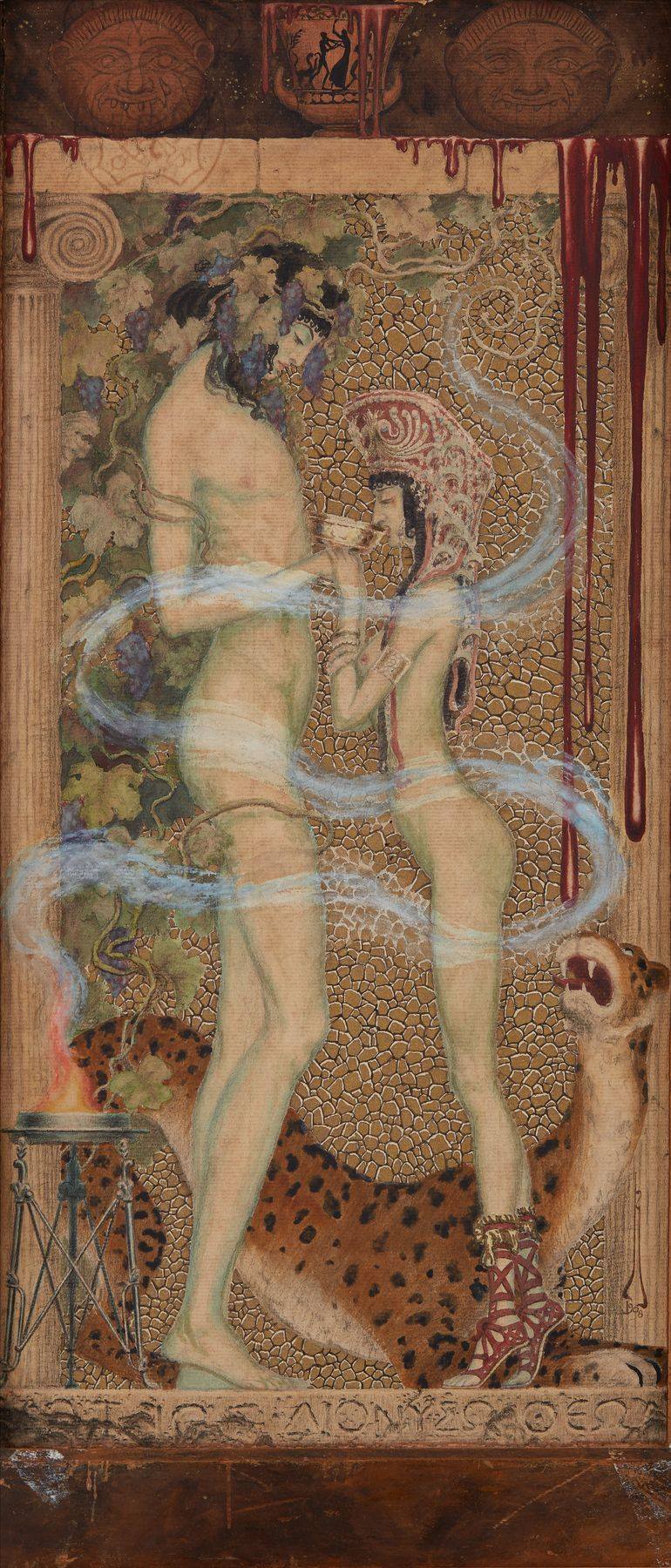
Dionysos Nicholas Kalmakoff (Russian-French, 1873–1955)
A Brief History of the Dionysos Cult
The original Rite of Dionysos is almost universally held to have been a "wine cult", concerned with the cultivation of the grapevine, and a practical, understanding of its life cycle - embodying the living god - the creation and fermentation of wine - the dead god in the underworld - and the intoxicating and disinhibiting effects of the drink itself, believed to be a possession by the god’s spirit. In the first instance the cult was not only concerned with the lore of the vine alone, but equally with all the other components of wine. It should not be forgotten that wine once more commonly included many other ingredients, herbal, floral and resinous, adding to the quality, flavour and medicinal properties of the drink. The cultivation of all these also originally came under the lore of Dionysos, making it a general vegetation cult and herbal school. Honey and bees wax were also often added to early wine, bringing with them the associations of the even older mead lore and Neolythic bee cults (whose swarms were often associated with Dionysos as pure "life-force"). Later beer, plus grain/corn, cults were also incorporated into the domain of Dionysos, particularly via his partial assimilation of the Thracian deity Sabazius. Other plants believed to be viniculturally significant were also included in the cults retinue. Thus were added ivy, once thought to negate the effects of drunkenness, and to be the opposite of the grapevine, blooming in winter rather than summer, the vine of death as opposed to the vine of life; the fig, thought to be a purgative of toxins, and the pine, a wine preservative, taken from the evergreen. Similarly the bull, from whose hollowed horns wine was once drunk, and the goat, who provided wineskins and was the natural pruner of the vine, were also included as cult animals and manifestations of Dionysos. The predators or enemies of these were equally sacred, idealised as the panther and the poisonous snake (but see also Sabazius for serpents). Naturally the mythos already associated with these elements would also accrue to Dionysos, if not already there from the start. An understanding of both the practical realities of these processes, and their wider metaphorical significance, is crucial to any attempted understanding of the later primarily symbolic Mysteries of Dionysos, with their atavistic, life-death cycles.
The place of origin of the Hellenic Dionysian Mysteries is unknown, but they almost certainly first came to Greece with the importation of wine, which is widely believed to have originated, in the West, around 6000 BC in one of two places, either in the Zagros Mountains (the borderlands of Mesopotamia and Persia, both with their own rich wine culture since then) or from the ancient wild vines on the mountain slopes of Libya / North Africa (the source of early Egyptian wine from around 2500 BC, and home of many ecstatic rites), quite probably from both. Whatever the case it appears Minoan Crete was the next link in the chain, taking wine from both the Egyptians and Phoenicians and passing it on to the Greeks by 1600 BC, who would spread it throughout their colonies. Wine probably also entered Greece over land from Asia Minor. But it was most likely in Minoan Crete that the eclectic ‘wine cult’, that would become the Dionysian Mysteries, first emerged. Gradually evolving over the centuries, absorbing more mythic material wherever it was adopted. The Dionysos Mysteries would remain powerfully syncretic, absorbing the suppressed primeval cults of all the lands they touched. It would be the Greeks who were left with the task of making sense of the eclectic mix that reached them, and of integrating it into their own mythos with their inventive tales of the journeys and adventures of Dionysos.
The basic principle beneath the original initiations, other than the seasonal death-rebirth theme supposedly common to all vegetation cults (such as the Osirian, which closely parallels the Dionysian), was one of spirit possession and atavism. This in turn was closely associated with the effects of the wine. The spirit possession involved the invocation of spirits by means of the bull roarer, followed by communal dancing to drum and pipe, with characteristic movements (such as the backward head flick) found in all trance inducing cults (represented most famously today by African Voodoo and its relatives). As in Vodoun rites, certain drum rhythms were associated with the trance state, and these rhythms are allegedly found preserved in Greek prose, particularly the Bacchae of Euripides. One classical source describes what had become of these ancient rites in the Greek countryside, where they were held high in the mountains to which ritual processions were made on certain feast days:
"Following the torches as they dipped and swayed in the darkness, they climbed mountain paths with head thrown back and eyes glazed, dancing to the beat of the drum which stirred their blood…. In the state of ekstasis or enqousiasmos, they abandoned themselves, dancing wildly…. and calling 'Euoi!' At that moment of intense rapture they became identified with the god himself…. They became filled with his spirit and acquired divine powers". Peter Hoyle, Delphi (London: 1967), p. 76.
Unlike many trance cults however, the Dionysian rites were primarily atavistic, that is the participant was possessed by animal spirits and bestial entities, rather than intelligible divinities, and may even "transform into animals". A practise preserved by the rite of the "goat and panther men" of the "heretical" Aissaoua Sufi cult of North Africa, and remembered in the satyrs and sileni of the Dionysian procession, and perhaps even the "bull man", or Minotaur, of the chthonic Minoan labyrinth. But the most desired possession was that by Dionysos himself, or his consort Ariadne, though given the primal nature of these deities this is hardly discernable beyond the degree of power manifest. This practise is represented in Greek culture by the famous Bacchanals of the Maenads, Thyiades and Bacchoi. Dionysos in this bestial manifestation is believed to preserve the archaic archetype of the "Lord of the Animals" or the "Horned Hunter", and to a certain extent also the ambiguous "Trickster" archetype. In fact his ‘religion’ tended to absorb the remnants of these archetypes from the local culture wherever it was adopted (usually into Dionysos himself, or else, if still strongly established, as a mythic accomplice, such as his favoured companion the Arcadian Pan, or the ancient Silenus). Likewise the primeval and chthonic goddesses would become associated with Ariadne, or his mother Persephone / Semele. This ritualised atavism was also associated with a ‘descent into the underworld’ of which Dionysos was lord (‘Hades and Dionysos are one and the same’, declared Heraclitus).
The purpose of this atavism is controversial, some see it simply as a Greek saturnalian catharsis, a ritualised release of repressed elements of civilised psychology, and temporary inversion, in order to preserve it, others see it as a return to the "chaotic" sources of being and essentially a reaction against civilisation, while yet others regard it as a magical connection with chthonic powers. It is likely all of these applied in different manifestations of the cult. Like wine, Dionysos had a different flavour in different regions, reflecting their mythical and cultural soil, or "Terroir", and appeared under different names in neighbouring countries (or so claimed the Greeks).
The fact that these effects were attributed in part to Greek wines, that were barely 15% proof, has led many, including Robert Graves, to conclude some of its additives were of an hallucinogenic nature. This is certainly supported by suggestions of a "magic potion" associated with the Dionysos rites, said to include poison ivy, and by the known use of datura, henbane and belladona by shamans in this region, as well as the alleged use of "kykeon" (probably ergot ale), and possibly fly agaric mushrooms, within the Greek Eleusinian Mysteries. Dionysos was most probably regarded as the patron of all consciousness altering substances in Roman times, and potion making paraphenalia have been found in the ruins of Bacchic temples (with the potions, and "poisons", of the Bacchants also featuring in Roman smear campaigns against them). The sacraments used probably varied with the intentions of the Mysteries at any one time, but remained central to all but the most domesticated of the Bacchic sects, as did the associated shamanic idea of stepping outside of an ordered world into something more fundamental.
This primitive Dionysianism survived well into late classical times times on remote Greek islands, and in the wilds of Thrace and Macedonia, but elsewhere was soon adapted to a more "civilised" culture. A spectrum of such sects was to be found across the Greek world, but the height of domesticated kind was to be found at Athens, where atavistic possession became dramatic masked ritual within the Bacchic Thiasos (Greek coven or lodge), seeding the emergence of acting and theatre in the West (crafts also sacred to Dionysos, particularly at the great tragedy and comedy competitions in ancient Athens. From Tragedos, 'Goat Song', Death? And from Komos, 'Revelry'). The ethos of the rites also seems to have become slightly less atavistic and more liberative and sensual in Classical Greece, and a place where the repressions and inequalities of civilised culture could be evaded, albeit temporarily. Thus many of its initiates tended to be women or slaves, the most repressed classes in Greek society, from whom its "leadership" was often drawn, in a typical inversion of normal society. This inversion in fact became a theme of the Dionysian Mysteries, and the Thiasos a place where even kings and rulers could throw off the pressures of rule and convention, and live in carefree, natural equality with commoners for a while. Thus the Mysteries of Dionysos would be adopted by figures as diverse as Alexander the Great, popular monarchs such as Mark Anthony, and rebellious slaves such as Spartacus, all of whom were initiated, and all of whom considered themselves embodiments of Dionysos, interpreting his "liberation" in different ways. But perhaps the most famous of all initiates were the anonymous Maenads, or "wild women", who led the orgiastic rites of Dionysos and became possessed by his frenzy, or the more sensual Thyiades, who raved in the hills. While relatively tamed on the mainland by late Classical times, there still seem to have been outbreaks (or rumours of outbreaks) of primal Dionysianism in Greece, often associated with "foreign influences", the cult itself being seen as originating outside Greek civilisation. These outbreaks were both feared as potentially socially disruptive and envied with great fascination, one such incident inspiring the Euripides' play, the Bacchae.
The Hellenic world, after Alexander’s conquest, spread the cult of Dionysos internationally, to Egyptian Alexandria, where he was associated with Osiris (eventually merging with him as Serapis); to Palestine, where he was associated with the Baals, and even the Adonai of the Jews (who had Dionysos imposed on them by the Hellenes); and most far flung of all, to India, where he became associated with Shiva. These various connections all fed back to the Aegean, where the cult became increasingly complex and cosmopolitan. This would also led to a breakaway mystical form of Dionysianism that would become part of the more philosophical Orphic and Pythagorean Mysteries (where Dionysos was effectively seen as the creative Primal Chaos before creation, beyond all manifest duality, as well as the paradoxical, dynamic balancing force still active within it, the ‘King of the World’, whose final liberation included not only that from orderly civilisation but from the natural world itself!), a move in sharp contrast with the earthy and irrational primitive rite of Dionysos, that in some places still existed alongside it (reflecting a similar pattern to the evolution of Shivaic cults). A complex evolution still not fully understood.
The evolution of the Dionysian Cult continued in the Roman Empire, where the Bacchic Mysteries, as they were known here after their arrival in 200 BC, were banned for a time in Rome and forced underground, following rumours of their "corrupt" and "subversive" behaviour (In 186 B.C. the Roman senate had sought to ban the Dionysian rites throughout the Empire, and restricted their gatherings to no more than 13 people, but was never fully successful. They were revived under Julius Caesar around 50 BC, and remained in existence, along with the Bacchanalian street procession, at least until the time of Augustine (A.D. 354-430)) Those Bacchic cults that survived into late Roman times are often considered degenerate forms, tending to be either rites of empty public theatre, or private excuses for orgies and drunkenness, but it now appears a few low profile Thiasoi did remain, particularly in Southern Italy. It is not surprising that early Christians should thus equate Bacchus and his company with the Devil (despite adopting quite a few of his cult trappings themselves, most obviously the wine communion). The purest survival of the Bacchic cult is perhaps the Lent Carnival which survives in Latin countries even today.
Today people often claim the precursors of Christianity, Devil Worship and Witch Covens in the Rites of Dionysos, with probably both a little justification and much imagination.
63 notes
·
View notes
Text
Fallen angel - Wikipedia
Fallen angels are angels who were expelled from Heaven. The literal term "fallen angel" does not appear in any Abrahamic religious texts, but is used to describe angels who sinned. Such angels often tempt humans to sin.
SIN OF THE ANGELS
Lesson: The sin of the angels has been traditionally spoken of as a sin of rebellion. “I will not serve” is the statement attributed to satan and the other fallen angels. “I will not serve God or obey His will.” Recall also the statement that the serpent spoke to Adam and Eve in the Garden when he seduced them to act in disobedience to God by eating the forbidden fruit. The serpent convinced them to eat the forbidden fruit by saying, “For God knows that when you eat of it your eyes will be opened, and you will be like God, knowing good and evil” (Genesis 3:5, RSV-CE). This line also reveals the hidden first sin of the angels. They wanted to be gods. They did not want to serve the one God. They did not want to obey. They rebelled. They wanted to be the masters of their own destiny rather than to humbly submit to the plan of God for their lives.
BELMÔNT'S SIN: STREET IDENTITY MURAL CROWN APOTHEOSIS
In religion, apotheosis was a feature of many religions in the ancient world, and some that are active today. It requires a belief that there is a possibility of newly-created gods, so a polytheistic belief system. The major modern religions of Christianity, Islam, and Judaism do not allow for this. In Hellenistic culture, a mural crown identified tutelary deities such as the goddess Tyche (the embodiment of the fortunes of a city, familiar to Romans as Fortuna), and Hestia (the embodiment of the protection of a city, familiar to Romans as Vesta). The high cylindrical polos of Rhea/Cybele too could be rendered as a mural crown in Hellenistic times, specifically designating the mother goddess as patron of a city. Nightlife entertainment is often more adult-oriented than daytime entertainment. Location theory has become an integral part of economic geography, regional science, and spatial economics.
Example; Mt. Pleasant Road Pluto Effect Invocation Wing Transfer
NOCTU [PLUTO ANGEL/NOCTURNALIS]
(Left-handed Path Apotheosis Pluto-Mural Crown Wing Transfer) Angelology Acrostics Treatise Text: Material World Angels: Spiritual Angelology not Religious (Bible Influence: De Coelesti Hierarchia and Summa Theologica), Left Handed Path Apotheosis, Illusions, Dionysian Mysteries, Black Angel Wings, Sagittarius-Scorpio Sensory Overload Asperger's (Fetus Alcohol Consumption and Prenatal Hormones Vitamin) Birth, Virtue Heavenly Host, Pluto Evening Star Astral Body Planetary Intelligence, Self-Defication Mural Crown Horcrux Oversoul (STREGA), Change Oversoul to New Title (Salesian), Cardinal-Mutable Human Form with Fixed Spirit, Invocation Possession, Angelology Students, and Angel Philosopher), Mural Crown (Tutlery Deity, Civil Heraldy, Heraldy), Salesian Church Enterprises (Real Estate; Liberal Arts Immersion Schools; Gold; Athletics; Fine Arts), Philosophy (CAAB: Culture, Art, Aesthetic, Bohemian; 5 Senses City, Selective Sensory Development, Distorted Sensory Play, Sensory Overload Asperger's, Culture Antagonist Liberal Arts)
RUSSE NOIR (À MA SAUCE) FOOTBALL
À ma sauce Literally: To my sauce, True meaning: Suit my style
VEDETTE: 3-4-1-2 has 4 Pivot Formations so 5 Total: Transition to a 4-4-2 Diamond, Transition to a 4-4-2, Transition to a 4-2-3-1, Transition to a 3-3-1-3
Central African Republic 4-4-2 Diamond Variant: 1-3-4-2 (1) À ma sauce (Sweeper Deep-lying Playmaker Wingback) (4) Diamant (À ma sauce: Counterpressing Pivot Pressing Triggers, Sweeper-Winger Pivots, Overlapping Runs, W; V; I Box Keeping Formations) [Key Stats: Front Foot, Pressing Triggers, Clearance, Aerial Duel, Interceptions, Blocked Shots, Tackles, Final Ball, Key Dribbles, Overlapping Runs, Set Piece Taker] Spacing, Possession, Pass Completion, and Counter Pressing with Pursuit and Ambush Predation One Team Box Touches and Capture the Flag with Analytics-Geometry Total Football Trixie Bet on CNS Drugs (Xanax and Modafinil)
Define a run in one of two ways: (i) as a set of consecutive goals scored by one team, without the other team scoring a goal; (ii) as a set of consecutive scoring events by one team, each event being either a goal or one or more Set Piece. Play aggressive and with counter pressing and run it up on the score board in the first half and after halftime play defense. You get a break at half and it's easier to win when someone plays defense and looks for opportunities instead of Attacking.
Posterior Chain Super Compensation and Speed-Endurance (Elastic-Connective Tissue) Force-Velocity Curve; Crescent Moon Horizontal Plane Vertical Force Sprinting Mechanics.
WM or Diamond Rover Futsal Pivot Formation
Set Piece Stylistic Biomechanics: Shooting Knee at Wall for Curve and Placement Knee for Corner. Follow through with Shot with proper Body Alignment
W, I, M, V; Box Keeping Formation with 3 Centre-Backs
Knee to Feet or Shoulder to Feet Cradling for Touch/Entertainment
UEFA Front Office Curriculum
Museum d'histoire: Broken down into three major section — “A Lineage of Coaches Players and Places,” “Proving Grounds” and “Cultures of Basketball” — City/Game documents how basketball first found its origins in the neighborhoods of NYC and then went on to produce a roster of local legends who played everywhere from Rucker Park and the Cage on West 4th Street to Christ the King High School and St. John’s University.
Agility Ladder Eyes Pocket: Eyes Between Defenders Feet and Ball, Numbered Footwork V-Step (Shifting Defenders with Momentum) et L-Step (Explosive First Step), All moves should form a Triangle or an Incomplete Triangle (Coup de Pied)
*Push-Pull Sprint/Shooting Cycle: Pull Glutes et Hamstring; Push Calf et Quads for Sprints.
Sprint Size Up: A series of feint Karaoké dribble moves with Eye Tricks (Fake Pass) but Sprint Position Finish
Triangle Philosophy: All Dribbling Moves should form a Triangle or an Incomplete Triangle while using V-Step (Shifting Defenders with Momentum) et L-Step (Explosive First Step).
Thé Crescent: In Close Dribbling; Crescent Footwork with L Shapes (Paul Pogba)
On the Run Dribbling Moves: Letters and Shapes; Still Play 1 on 1: Numbered Footwork
Piedi Felici Courts: Drills Side/Box Play with 1 Net; Design Vaporwave Action Painting Angels; Knee for Direction and Sole Drags for Dribbling Touch and Crescent Moon Sprint Mechanics
Gambling Games: 5 Roll (Captain, Ship, Crew); Live-Pool Betting Monopoly
Stylistic Biomechanics: Dribbling Foot To Ball Contact (Balls of Feet and Arch of Feet); Knee for Direction; Foot Drags; & Hip Angle, Crescent Moon Running Mechanics, and Laces Kick.
Diamond Football (15 mins)
Set Up
-Lay out two overlapping sets of 4 flat markers in the positions shown above.
-Ask the players to stand on a flat marker for their teams colour (Red on Red, Yellow on Yellow).
Instruction
-Whenever the ball goes out for a kick in or for the defenders ball, the players must stand on their markers before play begins.
-As soon as the ball has been played in, players are free to move.
-Reset everytime the ball goes out.
Coaching Points, Progressions Ect.
-Ask players to shout out what each position on the park is to devlop understanding of their roles.
-If you decide to go to a normal game , leave the markers out for a visual aid for the players.
-If more than 8 players, Add in Goalkeepers who would then play the ball out to the DF,LM,RM.
-Rotate Positions, Ask Players to stand on a marker they haven't been on before
BELMÔNT'S ACCENT
Full Lips Endings with Vertical Narrow Mouth and Soft Rs
BELMÔNT'S SIN INDEX FUND PORTFOLIO
Sin stock sectors usually include alcohol, tobacco, gambling, sex-related industries (Cabaret and Burlesque), and weapons manufacturers.
Diageo
Phillip Morris
Sports Betting Investment Trust
Pharmaceuticals
Business Clusters with Scrum Management and Accelerators to produce Festivals.
Example: Create a Index Fund Portfolio of 15-20 Stocks and using Supply Side Economics to create Decentralized Gambling Economy.
BELMÔNT'S DECENTRALIZED GAMBLING ECONOMY
Corporate-Capital Gains Tax Haven
High Stakes Minimum Buy In
Card Gambling (Signal and President): Top 2 highest bids fight for the Coup d'état and the other two are lesser men, the lesser men are subordinates that aid in playing cards for the warlord, the winning team splits the money, the warlords switches based on the 13 cards dealt and bets placed, the first team to shed all of their cards win.
Domestic Gambling: Boxing
Retirement Gambling: Boat Racing
Residency Program for Tax Benefits
BELMÔNT'S TURF ACCOUNTING MODEL
+EV
Python Programming Gaussian Distribution
Exotic Options Trading Live Betting
Parlays Minimum for Round Robins
Daily Fantasy Sports Rakes
NOUCHI PALACE
Definitions of ballroom. noun. large room used mainly for dancing. synonyms: dance hall, dance palace**. types: disco, discotheque.
Go Go Music Influenced, Eurphoric Trance Chord Progression Melody, Progressive House and Drum n' Bass Percussion-808 Call and Response Staccato Polyrhythm or Layered Kick and Punch 808.
In his 1972 study of French lute music, scholar Wallace Rave compiled a list of features he believed to be characteristic of style brisé. Rave's list included the following: the avoidance of textural pattern and regularity in part writing; arpeggiated chord textures with irregular distribution of individual notes of the chord; ambiguous melodic lines; rhythmic displacement of notes within a melodic line; octave changes within melodic line; irregular phrase lengths.
Have the Snare and Kick say, "Hi, How are you?" And the 808 say, "I am good thanks for asking.”
Use progressive House to push the Drums Conversation to either Fast and Punchy for Happy or Slow and Deep for Sad.
In technical terms, "go-go's essential beat is characterized by a five through four syncopated rhythm that is underscored prominently by the bass drum and snare drum, and the hi-hat... [and] is ornamented by the other percussion instruments, especially by the conga drums, rototoms, and hand-held cowbells."[5]
Polyrhythm: In music, a cross-beat or cross-rhythm is a specific form of polyrhythm. The term cross rhythm was introduced in 1934 by the musicologist Arthur Morris Jones (1889–1980). It refers to a situation where the rhythmic conflict found in polyrhythms is the basis of an entire musical piece.[1]
Four-on-the-floor (or four-to-the-floor) is a rhythm used primarily in dance genres such as disco and electronic dance music. It is a steady, uniformly accented beat in 4. 4 time in which the bass drum is hit on every beat (1, 2, 3, 4).[1] This was popularized in the disco music of the 1970s[2] and the term four-on-the-floor was widely used in that era, since the beat was played with the pedal-operated, drum-kit bass drum.[3][4] (Punch 808-Kick)
Polyrhythm 4 on the Floor examples 2:4 or 5:4
Hard trance is often characterized by strong, hard (or even downpitch) kicks, fully resonant basses and an increased amount of reverberation applied to the main beat. Melodies vary from 140 to 180 BPMs and it can feature plain instrumental sound in early compositions, with the latter ones tending to implement side-chaining techniques of progressive on digital synthesizers.
Singles Only Email Raves Blogger then Multi Market Distribution Deal: A distribution deal is a contract to release the music to platforms, but not own the publishing or exclusively lock the artist in. Record Artist Producer Label: Have Polyrhythm Artist earn Streaming Percentage under a Recording Artist Deal. Label has Distribution Above Me and I have Manufacturing over Polyrhythm Artist. Have a end of the Year Album for New Year's Raves!
"ALWAYS WELCOMED" by POPCAAN
No jezebel can't enter di Heaven gates
Angels only
She wan pull up a long time she ah wait
Guyanese girl dem ah heavyweight
Pretty girl always welcomed (Trouble)
Tight pussy gyal always welcome
Gyal yuh body hotter than Kingston
Tight pussy gyal always welcomed
Love when yuh bubble up, mi wan lock you down
Tight pussy gyal always welcomed
Bend it over for me slowly
Tight pussy gyal always welcomed
Baby yuh thick like phone ah
Wan you sit down pon di throne yah
Love when you bend it over
Jump on the first flight to Arizona
Fuck you pon di dresser top slowly
Get yuh pussy wet rub yuh clit, hold me
Sink it in deep dat mi kno yuh love
Mek yuh draws fly weh like a likkle dove
Tight freaky girl wha me singin bout
Love when you put di cocky inna yuh mouth
Turn yuh back way and fuck it up right
Gyal yuh pussy tight, me will pay down
Mek yuh wine pon di body pon di head pon di pine
Underneath yuh nuh big like stadium
Wine fast a way now
Bite up di K now
Skinout and lay down, yeah
Pretty girl always welcome
Big pussy gyal always welcomed (Woioi)
Gyal yuh body hotter than Kingston
Tight pussy gyal always welcomed
Love when yuh bubble up, mi wan lock you down
Tight pussy gyal always welcomed
Bend it over for me slowly
Tight pussy gyal always welcomed
Cock up yuh pussy mi wan see it
Sit down pon di body like ah issa van seat
Pon yuffi gwarn badder although you conceit
Hot gyal ah George Town, hot gyal a Berbice (Trouble)
Love gyaldem freaky an bad yeah
Wine up and den turn it back weh
Open yuh legs dem fi Poppy
Hammer yuh body like Rodney
I'm giving you a rough ride
Love when you ride on me
I'm giving you a rough ride
Love when you ride on me
Baby
Love when you ride on me
Pretty girl always welcomed (Trouble)
Tight pussy gyal always welcomed
Gyal yuh body hotter than Kingston
Tight pussy gyal always welcomed
Love when yuh bubble up, mi wan lock you down
Tight pussy gyal always welcomed
Bend it over for me slowly
Tight pussy gyal always welcomed
Pretty girl always welcomed (Trouble)
Tight pussy gyal always welcomed
Gyal yuh body hotter than Kingston
Tight pussy gyal always welcomed
Love when yuh bubble up, mi wan lock you down
Tight pussy gyal always welcomed
Bend it over for me slowly
Tight pussy gyal always welcomed
BELMÔNT'S SYSTEM: CAPÔI RETAINER AGREEMENT WITH ASSET PROTECTION TRUST
Capo: Describes a ranking made member of a family who leads a crew of soldiers. A capo is similar to a military captain who commands soldiers. Soldier: Also known as a “made man,” soldiers are the lowest members of the crime family but still command respect in the organization.
A capo is a "made member" of an Italian crime family who heads a regime or "crew" of soldiers and has major status and influence in the organization.
Consigliere: Defense and Corporate Lawyers
Head Boss: Ministry of Medicine
Underboss: Pharmaceutical Industry
Capo: CAPÔI RETAINER AGREEMENT
Soliders: Artisans
Commercialism is the application of both manufacturing and consumption towards personal usage, or the practices, methods, aims, and distribution of products in a free market geared toward generating a profit.
Commercial art is art created for advertising or marketing purposes. Commercial artists are hired by clients to create images and logos that sell products. Unlike works of fine art that convey an artist's personal expression, commercial art must address the client's goals.
The word 'Commercial' is defined as follows: Concerned with or engaged in commerce. Commerce is the exchange of goods or services among two or more parties.
Craftsmen are committed to the medium, not to self-expression. Artists are committed to their self-expression, not the medium.
A medium of exchange is an intermediary instrument and system used to facilitate the purchase and sale of goods and services between parties.
Stretch and Micro Goals
Music Medium System: Distribution and Retailers Contract Theory (System) for Music (Instrument)
Football Medium System: Analytics and Geometry for Free Role (System) Trixies (Instrument)
Age 16-19
Bond Funds
Farmland REITS
CFDS
Real Estate Brokerage Trust Account
Age 20-30
Farmland Recession Proof Stocks (Cosmetics, AgTech, Ag ETFS, AgETN)
Incubator and Startup Accelerators
Real Estate Joint Ventures
Age 30-40
Farmland Blue Chip Indexes w/ Credit Spread Options
TUNNEL STRATEGY (OFFSHORE BANKING)
Purpose: Permanent Residency Card
$250k Deposit
$125k: 60/40 portfolio, 60% Fixed Income & REITs and 40% Blue Chip Stocks
$50k: Guaranteed Investment Certificates (GICs) and term deposits are secured investments. This means that you get back the amount you invest at the end of your term. The key difference between a GIC and a term deposit is the length of the term. Term deposits generally have shorter terms than GICs.
$75k: Spending Cash
SIN STOCKS PORTFOLIO
Sin stock sectors usually include alcohol, tobacco, gambling, sex-related industries, and weapons manufacturers.
Sports Betting Investment Trust
Pharmaceuticals
Example: Create a Index Fund Portfolio of 15-20 Stocks and using Supply Side Economics to create Decentralized Gambling Economy.
FESTIVALS DEAL
Singles Only Email Raves Blogger then Multi Market Distribution Deal: A distribution deal is a contract to release the music to platforms, but not own the publishing or exclusively lock the artist in. Record Artist Producer Label: Have Polyrhythm Artist earn Streaming Percentage under a Recording Artist Deal. Label has Distribution Above Me and I have Manufacturing over Polyrhythm Artist. Have a end of the Year Album for New Year's Raves!
NEUROPLASTICITY DRUG-CRIME NEXUS BASED ON TRAFFICKING
CPP, CNS Depressants, et FENTALOGS: Cul-de-sac
Defensive Penalty Capture The Flag Raiding Warfare
Grey-Decentralized Markets
Bastilles: Cul-de-sac Artist Résidences Penthouse Complexes
Polyrhythm Raves
Acid House Art Gallery
International Film Festival
Hôtel Chefs
Seigneurial System/Tableau Economique Raw Material Économics Production Spot
Surautomatism
Discount Networking Acid House Party
Opium Dens and Fragrance Festivals
Pill Pressers
CNS depressants
Upper-tier County System
Defense Lawyers are Traplords (Trafficking P4P and Malicious Prosecution)
Cash Conversion Cycle (CCC)
Brain Receptor Dealing
Neuroplasticity Drug-Crime Nexus
Religious Ecstasy
Entheogens are psychedelic drugs—and sometimes certain other psychoactive substances—used for engendering spiritual development or otherwise in sacred contexts
Live-Pool Betting Monopoly Board Game
Summary Sentencing
Urban Level: Street Culture Art Gallery (Street culture may refer to: Urban culture, the culture of towns and cities, Street market, Children's street culture, Street carnival, Block party, Street identity, Street food, Café culture, Several youth subculture or counterculture topics pertaining to outdoors of urban centers. These can include: Street art, Street photography, Street racing, Street wear, Hip-hop culture, Urban fiction, Street sports, Streetball, Flatland BMX, Freestyling), Art Pedagogy, Artist Residency, Art Schools, and Art Plugs
Art Pedagogy: Arts-based pedagogy is a teaching methodology in which an art form is integrated with another subject matter to impact student learning. 28-30. Arts-based pedagogy results in arts-based learning (ABL),11 which is when a student learns about a subject through arts processes including creating, responding or performing. Aesthetic Teaching: Seeking a Balance between Teaching Arts and Teaching through the Arts. In aesthetic education, learning must be developed especially with the inclusion of sensations and with the help of feelings. Sensations and feelings should lead to movement, representation, and expression. Aesthetic learning often entails learning to distinguish certain qualities or objects aesthetically in different ways depending on the situation and the purpose. Certain things can be experienced in negative ways in one activity and in positive ways in another.
A designer drug is a structural or functional analog of a controlled substance that has been designed to mimic the pharmacological effects of the original drug, while avoiding classification as illegal and/or detection in standard drug tests
Patchwork tattoos are a collection of tattoos collaged together to create an overall design. Each individual 'patch' of the tattoo can be a different design, symbol or element with a little space in between. Patchwork tattoos are a collection of tattoos collaged together to create an overall design. In short, the gun-toting angel was a multifaceted metaphor. “It undoubtedly also reflected the Catholic Counter-Reformation militaristic rhetoric,” wrote Donahue-Wallace, “which promoted the church as an army and heavenly beings as its soldiers.”
DECADENCE AESTHETICS THEORIES
Slogan
J'Cartier, Je cours après les vœux de champagne,
Subjective
Based on or influenced by personal feelings, tastes, or opinions
Gastronomy
Precarious Balance
Precariously: If something is happening or positioned precariously, it's in danger. A glass could be precariously balanced on the edge of a table. If something is on the verge of danger, then the word precariously fits.
Grey & Decentralized Markets
Tableau Économique
Semblance
Semblance is generally used to suggest a contrast between outward appearance and inner reality.
High Socioeconomic Status & Tattoos
Phantasmagorical
Having a fantastic or deceptive appearance
adjective. having a fantastic or deceptive appearance, as something in a dream or created by the imagination. having the appearance of an optical illusion, especially one produced by a magic lantern.
Socioeconomic Status Development Immigration Multilingual Sensory Play
Law of Polarity in Relationships
In any successful relationship that has an intimate connection and sexual attraction, there is polarity. What does this mean exactly? Polarity in relationships is the spark that occurs between two opposing energies: masculine and feminine. Gender does not affect whether you have masculine or feminine energy.
Second Reflection
Burden Aesthetics with Intentions
The Second Reflection lays hold of the Technical Procedures
Tattoos
NOCTU
21 notes
·
View notes
Text
"According to the Athenian myth, a missionary named Pegasos first brought the image of Dionysus Eleuthereus from Boeotia to Athens (Σ Ar. Ach. 243 Wilson). But when the Athenians rejected the god he afflicted their genitals with an incurable disease. Delphi declared that the sole cure was for Athens to hold the god in all reverence. They therefore constructed phalloi and with these paid homage to the god and made them a memorial to their suffering.
The modern literature sometime explains the disease as impotence, but it is just the opposite: it is hyperpotency (satyriasis or priapism). The Icarian myth is more explicit (Σ Lucian Dial.D. 1-5 Rabe). Dionysus gave the farmer Icarius a vine. He grew it, harvested it and offered the juice to his neighbours. They drank it and felt the effects of wine for the first time: overpowered, some of them fell into a stupor, others into a drunken rage. Assuming that Icarius had given them poison, they murdered him. To avenge the murder, Dionysus appeared before the Icarians in the form of a beautiful boy and flirted with them until they reached the peak of excitation, and then Dionysus suddenly disappeared leaving them in this unabated state, until an oracle advised them to put a stop to their madness by fashioning and dedicating images of their afflicted genitals. Another myth says the same about satyrs, except satyrs never found the cure (Σ Clem. Al. Protr. 47.5, p. 314 Stählin). It is clear that the disease of the first myth and the madness of the second are equivalent and that the symbol of this divinely inspired madness is the phalloi."
The Dionysian Parade and the Poetics of Plenitude — UCL Housman Lecture by Professor Eric Csapo
#greek mythology#greek myths#greek gods#tagamemnon#hellenic deities#Dionysos#Dionysus#he was such a tease he drove them mad I love it
22 notes
·
View notes
Note
Hi, it's me again! I hope I'm not being annoying, but can I have headcanon for M6 with a MC who accidentally took aphrodisiac? Thanks!
Not annoying at all! Happy to be your smut dealer lol
Before we start, a disclaimer: I imagined this scenarios in a situation of uncinditional trust and consent. I've often read of "funny" fantasy situations with potions & love magic involved where one character ends up being intimate with another just because they unknowingly took (or were given!!!) something to have them behaving in that way. To me, this is the fantasy equivalent of rape. Having someone consent to sex or being involved in a continuative relationship while under the effect of *anything* it is not ok. So, I really want to specify that this HCs are consensual, and happen in an established, explicit relationship in which consent is unconditional (of course, such a situation is possible only in a fantasy setting. No irl relationship has unconditional and total consent).
Aphrodisiac Headcanons
♤•��•♧
Tw: light bdsm, embarassment, rough
There are a few things to keep in mind while working at a magic shop. First thing is, there are no such things like "substitutions". When cooking, you can switch eggs with seed jelly and flour, or butter with milk, and expect a decent result. With magic, you can't. You know this, but sometimes mistakes do happen. Switching sage with white sage it's so easy in a dark evening... and breathing in the vapors that rise from the cauldron can create unexpected events.
Portia is delighted by your attentions, today. She can't wrap her head around why you're so eager to see her, though. You knew she was working, but couldn't stay away from her... after all, the palace is so big that's easy to "get lost" in it, and the thunderstorm is dark and noisy... Who will be able to hear her moaning?
She's on her knees now, her head firmly pressed against your groin by your greedy hands. It wasn't hard to get her there: you brought her to the brim of an orgasm as she had her hands buisy doing laundry, and then threatened her to leave her that way if she didn't follow your indications. Luckily, she didn't see through your bluff, and literally fell at your feet... but in reality, you could have never truly resist to make her come.
Lucio doesn't seem to realize what happened. Of course you can't wait to be with him! You end up spending the day in bed, going so many rounds that eventually the bedsheets are soaked in sweat... and something more.
When Lucio is finally drained and exhausted -for the first time you bettered him!- he starts wandering how the hell your all up and ready for more. He tries to go one more round, but he's done, and almost passes out on top of you. You look at him sleeping, wondering if you could hack his magical gauntlet somehow to ho ahead, but eventually you decide to let him sleep. Who knows, maybe Nadia is still awake...
It takes a few seconds for Asra to understand what's happened. He stops you halfway, he takes a look at your mistake and he knows right away that him alone would end up destroyed before you'll be satisfied. The solution it's clear and simple. Orgy.
-work in progress! Tumbr app is giving me some problems lately ^^" I'll add the other m6 in a bit
One thing Asra doesn't lack is a wide list of friends who will gladly have a ride. The desert house is the perfect place, so isolated and silent... well, until it's filled up with moans. As you're engaged in various filling activities, you cast a glance at him, and see him sitting in the middle of the room, surrounded by men and women both, almost like an ancient dionysian demigod in a bacchanal.
At first, Muriel doesn't understand why you're like this, today. When you manage to stop blabbering and staring at his bare chest, you explain to him what happened. He's not exactly embarrassed, but he doesn't want to be with you if he has reasons to think you only want him because of some external factor. So, you ask him, you beg him and you pray him and cry, because you need him to fuck you, but there's no way to convince him.
Eventually, he agrees to lie down next to you, on his bed. You spend the night trebling close to his body, wishing to have more than his body heat that radiates from the tight hug he's holding you in. By the morning, you're exhausted and your tights are so, so wet. The effect is wearing out.
Only then, Muriel agrees to take you, slowly, as you struggle to stay awake just as your body struggles to stretch around his girth. He has a sweet smile, now that he knows you want him nonetheless... but is there a glimpse of fun in his eyes?
#the arcana#the arcana game#portia devorak#portia x reader smut#portia x reader#portia devorak smut#asra the magician#asra alnazar smut#asra alnazar#asra x reader smut#asra x reader#muriel arcana#muriel of the khokuri smut#muriel smut#muriel x reader smut
78 notes
·
View notes
Text
I am once again thinking about how hard theatre at Camp Half-Blood would go:
Athena kids working as Scenic Designers, Stage Managers, etc.
Iris and Apollo kids working as Lighting Designers and Electricians
Haephestus kids working as Props Artisans and Scenic Carpenters
Aphrodite kids working as Hair and Makeup and Costumes
Dionysus kids working as Assistant Directors, Actors, etc.
Hecate kids doing all sorts of cool as fuck special effects
Satyrs and the Demeter kids finding some way to remake the wood used from the set pieces back into trees for the woods. Quick and easy strike AND environmentally friendly!
Basically i just think that the fact Mr. D is Camp Director and also the God of Theatre means that CHB should have a Dionysian festival
15 notes
·
View notes
Text
latest 50% rule!

transcriptions of my handwriting (top to bottom, left to right):
the lovely Roman maiden
"Don't fucking talk to me, I'm one patronizing comment from finding Melia and murdering patricians with my tits out"
"mom pick me up im scared"
the perpetual dionysian girlie
the former dionysian girlie
do you think Margaret Thatcher effectively utilized girl power?
MELIA! (abt to go to the bodega nearby to buy a juul refill)
(also known as ASH!)
4 notes
·
View notes
Text
Mycogenous – a book exploring Dionysos in the fungal realm
This isn't my book. This is Dver's book. And it is something she has been working on for some time as part of her devotion to Dionysos.
"Dionysos has always come first for me – I discovered Him before I was even properly pagan, and He was the first god I came to when I started studying polytheist traditions, and has remained by far the most important god to me, sometimes almost to the point of henotheism. I think of myself as a Dionysian as much as anything; He is at the core of who I am. And yet, all these years, everything I’ve written, and only now have I finally created a book entirely dedicated to Him. Only now do I feel I have something to say, to share, to offer those looking to connect with Him. Something very special to me."
This is a different Dionysos than most people encounter. This is not the Dionysos of the revelry, of the enthused intoxication, of the excess of movement and sound and action.
"For this Dionysos is not the familiar god of the wild animal, or the verdant vine, but rather a fungal god – not just symbolically but literally. He is the Dionysos that brings life out of death, that dissolves boundaries, that opens doors, that effects transformation…all through the varied manifestations of the fungal kingdom. And no, I am not just referring to mushrooms (mind-altering or otherwise), although they are part of it. I’m also talking about the kind of fungus that rots the dead, the kind that intertwines with trees, the kind that turns grapes into wine, the kind that heals, the kind that destroys, the kind that spreads and changes everything it touches. I have taken to calling Him by the title Mycogenous Dionysos."
This is not a history book. Not an art book. Not a text book of spells and rituals. This is a devotional.
"In this book, I use a combination of prose, poetic allusion, and visual art to convey something of what I have experienced and learned, in hopes of helping the mycelium of Mycogenous Dionysos to spread. I don’t know who, if anyone, will feel called to this path, or resonate with it, or be taken wholly by it as I have, but I know I need to put it out there. I need to release the spores; it is not up to me where they land."
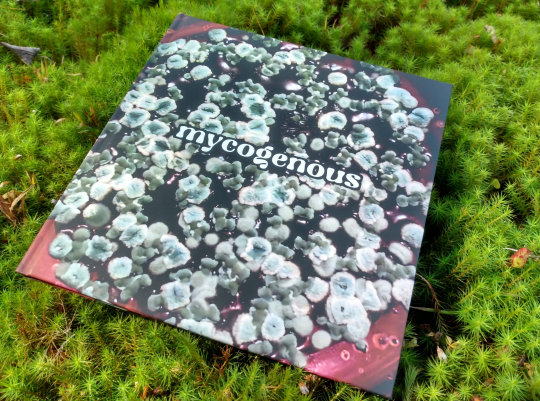
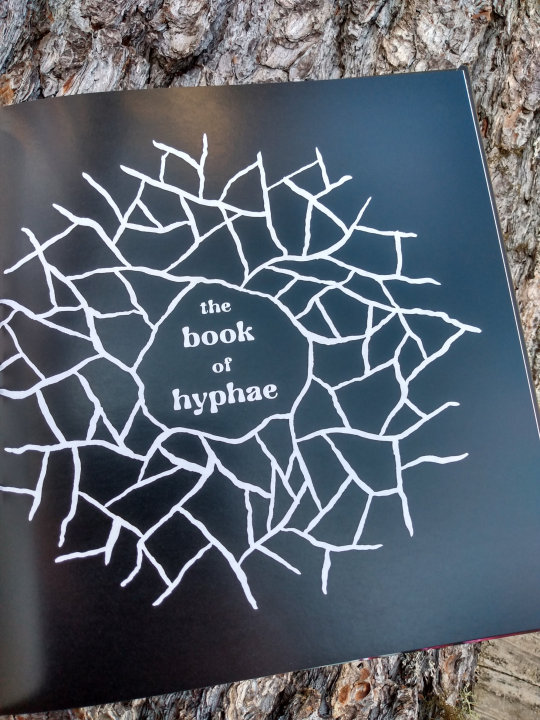
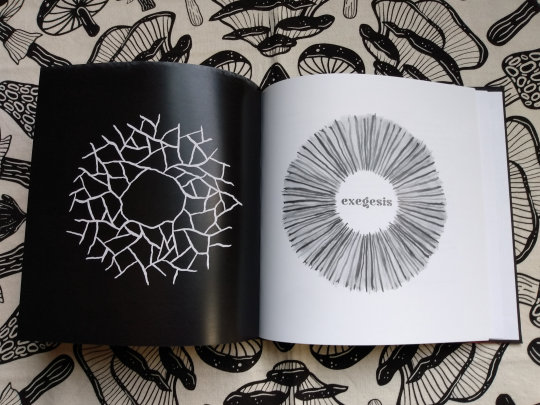
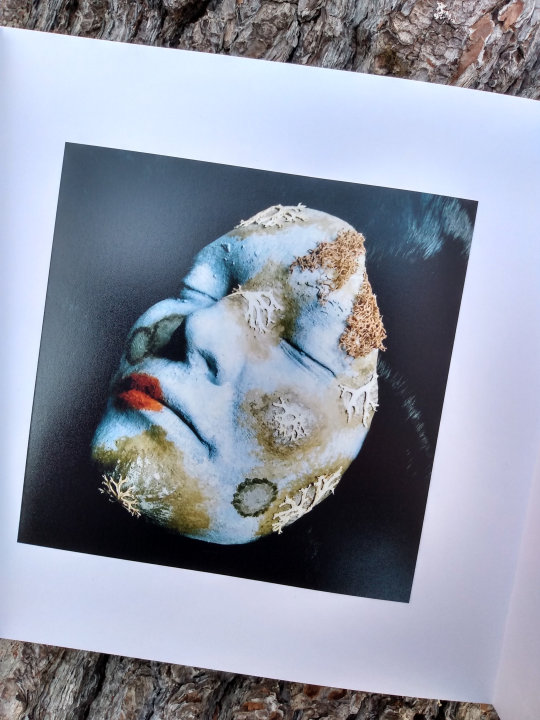
Mycogenous 7.5×7.5 inches, 82 pages, 80# semi-gloss paper, matte casewrap hardcover "Incorporates reproductions of several original ink and brush illustrations created for this project, as well as three tipped-in color plates of masks I made several years ago as I began delving further into this path."
Available only in Dver's Etsy shop
As always, I would appreciate any help spreading the word about this, as I do not have social media or any other way to communicate beyond this blog and my shop. While I wrote this for polytheists and especially for Dionysians, I do wonder how it might resonate with those unfamiliar with the god but drawn to fungi or spiritually connected to nature, so please feel free to disseminate beyond the pagan world.
If you would like to encounter more about Dver, her devotional practices and offerings, and her other works, her blog can be found at https://forestdoor.wordpress.com/
#Dver#Dionysos#fungus#mold#devotion#pagan#book#Mycogenous#If you know someone this would interest please share this post.#Dver does not do the socials.
21 notes
·
View notes
Note
Is it bad that after reading your soundwave dionysian ritual thing my first thought was "and that kids is the story of how I met your mother"
You're actually not far off.
In the Dionysian Effect, I'm going to explore more gladiatorial culture and influence upon Soundwave as well as the religious/spiritual impact of the Thirteen, especially what drives some mecha to name themselves after such beings. (Gotta be more than hubris, right?)
I headcanon that he came to the Pits as a sparkling (pre-adolescent child), so it greatly shaped his outlook and values. In particular, the surviving practitioners of the Cult of Megatronus among life-long gladiators and the Volupi (think of them as indentured prostitutes by the gladiatorial clades).
But going back to the story, it's very AU for sure. There are definitely more artifacts from the Iacon database, especially Primal ones with certain effects.
Soundwave thinks it's a Sign from his chosen Prime that the artifact he was tracking was not only Megatronus' and Solus', but it latched onto the stranger due to the... prerequisites to activate it. He's claiming her as a War prize/spouse since Megatronus "obviously" had a hand in getting a "Wilder" femme on Earth of all places, so who is he to deny the will of Megatronus Prime and of Primus?
(I'm smashing in tropes that I enjoy into the fic, including humans-into-Cybertronians, so cue shenanigans of culture clash between Earth animal bride, magicks, and ancient Kaonite/Vosian wedding customs, and this is how Cyber!Jack was born in this AU.)
#ask#transformers#transformers prime#tfp#soundwave#gladiator soundwave#june darby#valveplug#humans into cybertronians#humanformers#cybertronian culture#cultural misunderstandings#The Dionysian Effect#magic#megatronus prime#fic ideas#My thoughts
65 notes
·
View notes
Text
First, please don’t feel you have read this whole thing-it’s a stream of consciousness love letter. Dearest, dearest, dearest To Venus And Back💗 you are my second favorite Tori record, and my only “ all purpose” one, meaning I don’t have to be in a particular mood, I just push play and float in your interplanetary glow. If I had to describe you in one word, it would be LUSCIOUS. I’ll never forget Tori describing Venus on VH1 Women First as “a bleeding watercolor coning out of your speakers.” Listening this morning, I was taken aback by the perfection of every note, every breath, every sound. So I’m doing things differently this time-going song by song to luxuriate in your beauty.
-Bliss-the last cassette I bought “in real time.” Your dark, mysterious tone, your driving intensity of the last, repeated chorus, the timbre and tone of Tori’s voice (here and throughout the record), the “weird Tori-“ness of the verses, the “I said”’s. So freaking good
-Juarez-Bliss is fantastic, but it was when I heard Juarez for the first time, I KNEW this record would be thebomb.com. Only T could make just 3 piano notes so haunting and effective. The percussion, the “rubber band” twanging sound (obsessed) the background harmony, the lyrics, the breathy vocals and the way they trail off at the end of some of the lines. I always envision a purple desert(all the songs are purple. The songs and the album art mirror each other completely)
-Concertina-so light and airy, with some slightly jagged edges from guitar
-Glory Of The 80’s-it always tickles me that there’s HARPSICHORD in the very beginning. Another thing only T could do, make harpsi work in a song set in space. “Orbiting around”,always reminds me of Black Dove for some reason. Yaaaas Bugle Boy Models, Silicon Party Barbies, drag kings called Venus, and “karma drawn up in lines”-a nod to the prevalence of coke during the decadent decade! And yes, I bought The Story of O (in the wild at a used book store) because of this song
-Lust- my sweet, sweet, girl. You’re absolutely “one of my best friends out of all the songs,” and one of my most used phone alarms. Beautiful, ethereal lyrics, and a piano refrain that, like the slithery keyboard of Riot Poof’s chorus, never, ever, ever loses her shine. I listened to this song a lot when I was homesick at college. Love, love, love. She lives inside my bones
-Suede-subterranean, dark, purple and dull glowing green like electronic lights. The Pay Per View performance is my JAM. “Swallow her whole star intact-I mean!!
-Josephine-Such a dear heart. I love the stripped down recording against sparkling mental images of Paris at night, looking out over the city. And “empty like the Tuileries” always carries extra poignance as an illusionto Tori’s miscarriages
-Riot Poof- MY GIRL! sensual, reptilian, warm, a GROOVE. Another song where I love all the sounds. The chorus has been my ringtone since 2008. A VIBE.
-Datura-I mean!!! Epic in every sense of the word, withThe epitome of lusciousness. The Dionysian, ancient vibe of the the first part, with a pagan veneration of nature herself, flower by flower. The flowers of Tori’s garden in Florida at the time and a real moment for anyone like me who loves Tori’s speaking voice. Then “is there room in my heart…” I alway visualize flying through dark space among the stars. The zinging/shooting star sound is one of my favorite sounds on the whole album. Obsessed. Then we float out even further to the “Dividing Canaan” part-when the percussion, especially the cymbals, becomes a intergalactic ocean where we swim, and swim, and swim. The first time I listened to this song, I thought a new song had started, and was confused. Later during that time, “Dividing Canaan” became a vehicle for me for meditative, centering practice. I would balance a book on my head and focus my attention in a meditative gaze. I remember specifically using the book Naked Lunch, I think just because it was around
-Spring Haze-more amazing percussion. More purple land and skyscapes. I’ve always loved the slightly melancholy mood of this song, and the rhythmic interplay of the vocals, drums, and piano is a great example of the sonically detailed layering on the entire album-you really have to listen to SH to hear everything-like Datura, Riot Poof, GOT80’s, and Juarez. The deepening ocean is warm and lulling
-1,000 Oceans- Simple yet beautiful, the only landscape (Salisbury Hill) that evokes the color green. The piano mimics calm ocean waves. Another comfort song of love and protection
-Zero Point-This girl!! Another epic, another visit to a now apocalyptic Paris. I believe T made the right choice putting Datura on the record. I love how Zero Point was such a mystery for so long though. Datura and Zero Point are intrinsically connected because their “format” is exacttge same, and yet they are completely unique in themselves. I really took the litany at the end into my spirit and my identity when ZP first came out, and like Lust, she’s in my bones. I think a lot about the power of the ancient, universal, leaning feminine force the narrator has ascended into-she has access to the Om, the Vatican Library, and other “places”where sacred/secret knowledge of the universe and the self without Ego can be found for those who are dedicated to a spiritual quest of self and universal knowledge. Years ago, someone was collecting essays for a book about different things Tori. Zero Point/secret knowledge, involving the Mayans, Buddhism, and other shit. So, an exploration of a facet of The Divine Feminine. The project fell through, but I read a lot and researched, and I still have all those notes. Maybe I should restart that project for my own academic curiosity and achievement.
I think it took me about 2 hours to write this. This album lives behind me heart, a place Tori talked about while promoting the album. I love, love, love her. Happy Birthday, love; I’ll go anywhere with you(and back) always and forever 💜💜💜💜







#album anniversary#to venus and back#tvab#21 september 1999#juarez#riot poof#spring haze#lust#datura#bliss#zero point
3 notes
·
View notes
Text
Dionysos: Why paint him fat?
I want to talk of a strangely specific topic that is however not only surrounding Greek mythology fans but also essential to understanding the character of Dionysos (or Dionysus, as English people call him - I never understood where the “us” comes from). Around this seemingly trivial question there is a whole cultural evolution to talk about. And this question could be summed up as: why is Dionysos fat? How come we went from an effeminate teen in Ancient times to a balding obese man in modern media? Let’s talk about Dionysos’ appearance.
As many of you know, in modern media, and that for quite some times now, Dionysos is depicted as a fat man. A fat drunk man, often balding or bald. The list of these large Dionysoses could be long, but as an example I’ll give you one iconic case: Disney’s take on Dionysos, which mixes the obese old man and the fat baby, and reflects how this “fat Dionysos” is associated with the joke that the god is just a useless and silly drunk here for background comical effect.

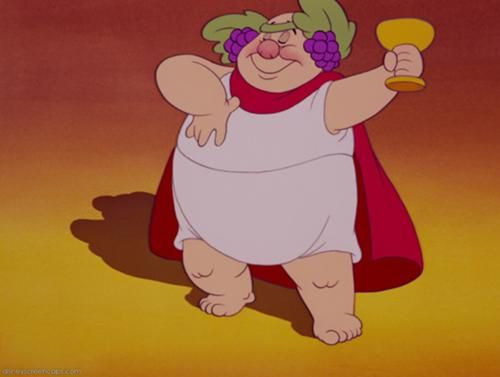
While you see this fat Dionysos in numerous recent-days movies, comic books and children books, it isn’t actually as “new” as we would believe. Before the 20th century it was already there. Most notably in paintings: Bacchus/Dionysos was often depicted as an obese man, either a ridiculous fat drunk or a grotesque ugly one.

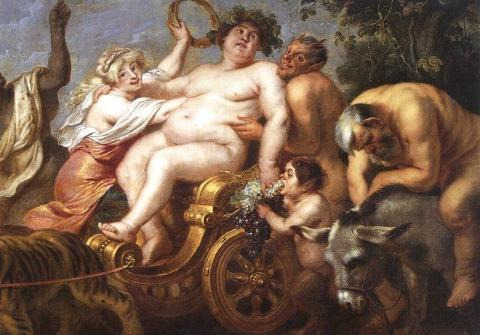
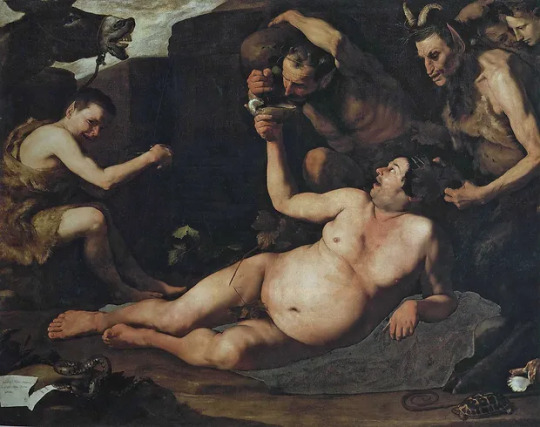
This image is so prevalent in modern-day culture, it cannot be ignored. But the questions I want to talk about here are: why does this depiction exist ; and is it a “good” way to depict Dionysos?
Because this obese Bacchus is the literal opposite of how the Ancient Greeks depicted Dionysos. As with all Greek gods he was a man of a great beauty with zero body fat (because for Ancient Greeks fatness was ugliness, and the gods are supposed to embody the ideal of Greek beauty) - even more, he was usually an effeminate and androgynous youth.
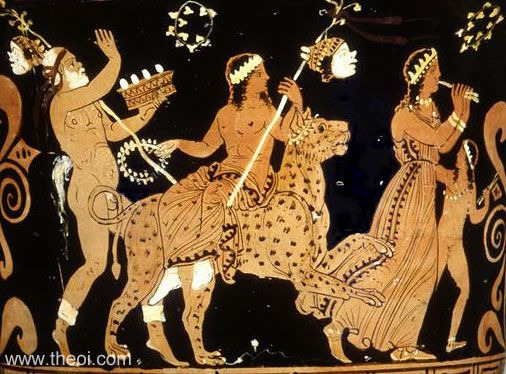


So how come this svelt teenage beauty became this old obese drunk?
A first answer is: the mythological confusion. Dionysos, in art, got confused with a close companion of his, the mythological figure of Silenus. Silenus, a satyr or man who was one of Dionysos’ besties, always with him, and who was attested as an old, fat man, constantly drunk to the point he often fell from the donkey he rode and had to be carried by others to stand up.
And so, while for a Greek the two were definitively separate - with time, painters and artists started to confuse the two and thought that the fat, elderly, drunk clearly not able to stand up on his own WAS Dionysos. Hence how the god inherited all of Silenus’ traits: the “comic” relief nature, the silly drunkness, the baldness, the large belly...

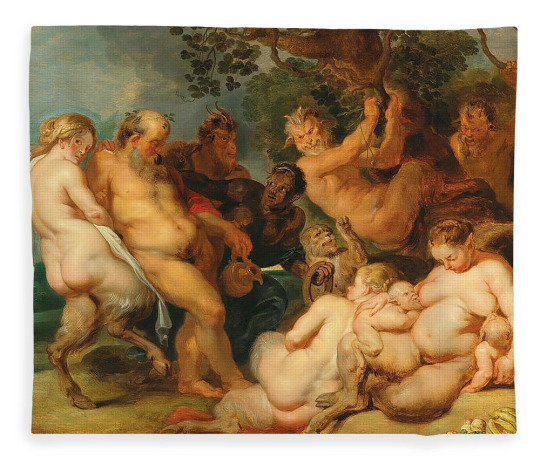

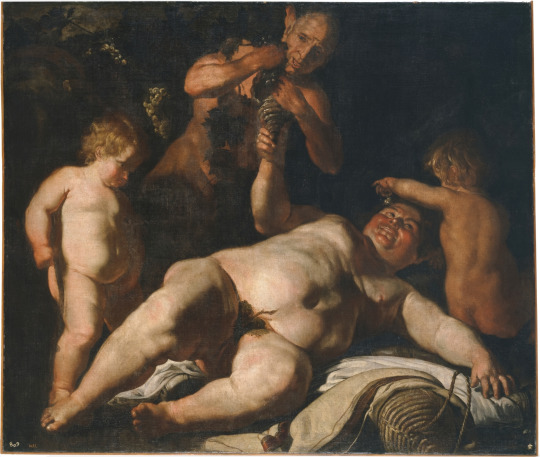
Plus, as times evolved and drunkness became condemned by modern societies as something vicious, dangerous and in general nasty, people saw this “Silenus portrait” of Bacchus as much more fitting: for them it represented everything drunkness and alcohol had to offer. Grotesque excess, laughable behavior with pathetic bodies, a waste through debauchery resulting in a god that doesn’t look like a god - a god becoming fat, bald and old among the slender and muscular youths.
But just to place Dionysos’ fatness on Silenus would be over-simplifying a vast and more interesting debate. Because Dionysos was painted as fat long before he was confused with Silenus. You have quite a number of clearly Dionysian Dionysos, separate from the old satyr, youthful depictions of the god as a Greek god... but a chubby one. And that is because during the Renaissance era (to simplify the chronology a bit), ideal and beautiful bodies were painted - maybe not as “fat” as we would believe it today, but definitively plump and curvy. It was a tradition of the painting back then but also a different canon of beauty: skinny meant you were poor or vicious or ugly, having flesh on your body meant you were of good constitution, noble and healthy. People often limit it to the paintings of Rubens, who exemplified this “ideal fleshy body”, but it was something present among numerous painters across countries and centuries.
The Greek gods being the embodiment of beauty ideals, the living personification of aesthetic canons, their body weight also evolved depending on the culture depicting them. And so in Renaissance paintings you have soft-bellied Aphrodites with large hips, you have chubby Apollos, and you have fat Dionysuses. Randing from the god having chubby cheeks and a bit of pudge around the waist:
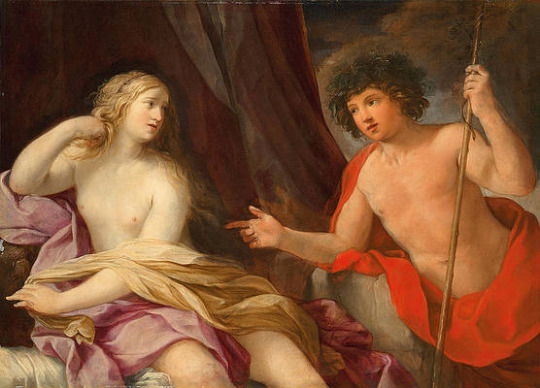

... to him being truly plus-size, with a big belly and fat rolls:
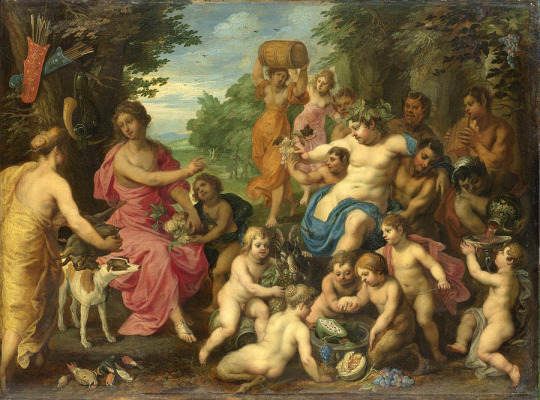
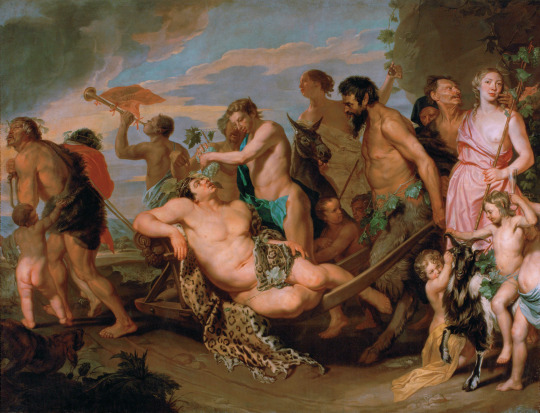
Not only was this a different standard of beauty, but depicting Dionysos fat also brought forward connotations of youth. In this type of paintings, children and teenagers were usually depicted with what we would call today their “baby fat” or “freshman fifteen”. It was the chubbiness of youth, and so with gods supposedly eternally young, curves were needed.
So, if we recap it all, Dionysos started as a slender youth in Ancient Greek, became a chubby youth in paintings, and then became the fat old guy we see everywhere today. But even more - we could say that Dionysos did a full barrel roll (no pun intended) from maturity to youth and back to maturity again. Because indeed, before being depicted as a slender effeminate youth, the older portraits of Dionysos in Ancient Greece depicted him as a mature, bearded man:
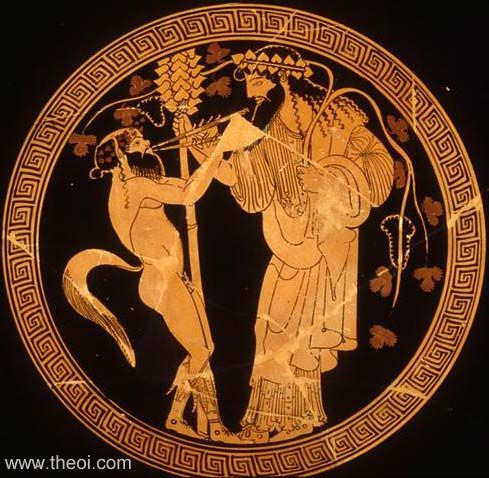
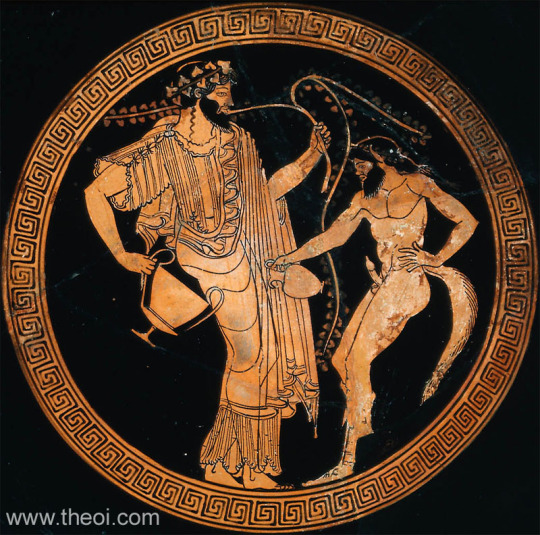

And so from a mature bearded god, we went to the androgynous teen, then to the plump young man, and then to the overweight old man.
But now I want to raise another question: is it a “correct” or “good” depiction of Dionysos?
This very question will make people scream because - and I agree with that - it should not be asked in such a way. In truth, people can depict the Greek gods any way they like because the gods are symbols and emblems before anything else - as long as someone gets the role, function, essence and symbols of a god, and as long as they show they understand the original Greek spirit, then they can draw the god in any height, size and color they like. But there is still a massive wave of people who want to “get things right”, who are not satisfied with just being faithful in spirit but want to be faithful to a T, and who will scream “IT WASN’T LIKE THAT IN ANCIENT GREECE!!”. And so I will answer them.
Yes, fat Dionysos is not how Ancient Greek mythology or religion would have depicted Dionysos. As I explained, gods aren’t fat in Greek mythology, because fatness is ugliness, and Dionysos was only depicted as either a mature bearded man or as a slender effeminate youth. BUT... it doesn’t mean fat Dionysos didn’t exist in Ancient Greece.
I present to you: Aristophanes’ The Frogs. A Greek comedy that depicts a parodic and humoristic take on Dionysos. Note that Aristophanes isn’t just any Greek writer - he was one of the “big playwright” that embodied Ancient Greek theater as a whole, and he was THE big writer of comedies who embodied the Ancient Greek comedy genre all by himself. (It helps that he was one of the few comedy writers preserved from Ancient Greece). So “The Frogs” isn’t just some random little thing, it was a popular, renowned and well-known play in Ancient Greece. And in it, Aristophanes presents us a caricature of Dionysos as a plump and rotund character, with a prominent, round belly, and who is called “fat” or “pot-bellied” by other characters. The whole point of making Dionysos fat was actually double. On one side, this fat Dionysos served the point of the play, as the plot was about comparing Dionysos and another famous half-god turned full god: Herakles. And Dionysos tried to emulate the strong, brave, muscular Herakles, when in fact he is a fat, lazy and cowardly figure. (Of course there is a commentary of how Herakles became adored through exploits, battling monsters and leading quests, Dionysos essentially became a god for very passive things such as getting drunk on wine). On the other side, making Dionysos fat was a caricature of Dionysos’ androgyny, as for Ancient Greeks fatness made the body of the man effeminate (the fat chest of a man is similar to the one of a woman ; a fat man’s belly is like a pregnant woman’s ; fatness makes the man’s hips wider and more female like, etc...).
So yes, fat Dionysos did exist in Ancient Greece. A theatrical and parodic version of him, but still.
In recent media the concept of the “old fat Dionysos” seems to have been gotten rid of, as most modern stories choosing to return to the more traditional depictions of him:



But hopefully fat Dionysos hasn’t been gotten rid of completely! Hopefully because while I don’t personally like Dionysos’ depiction as a “Silenus-like” character, I do think that the past of Dionysos as a fat god shouldn’t be entirely ignored, and could be reused in a world open to more body types in media. What is interesiting however is that recent media, when they keep fat Dionysos, actually play with it or justify it instead of doing the simple “old fat drunk” cliche. See Riordan’s take on Dionysos/Bacchus:
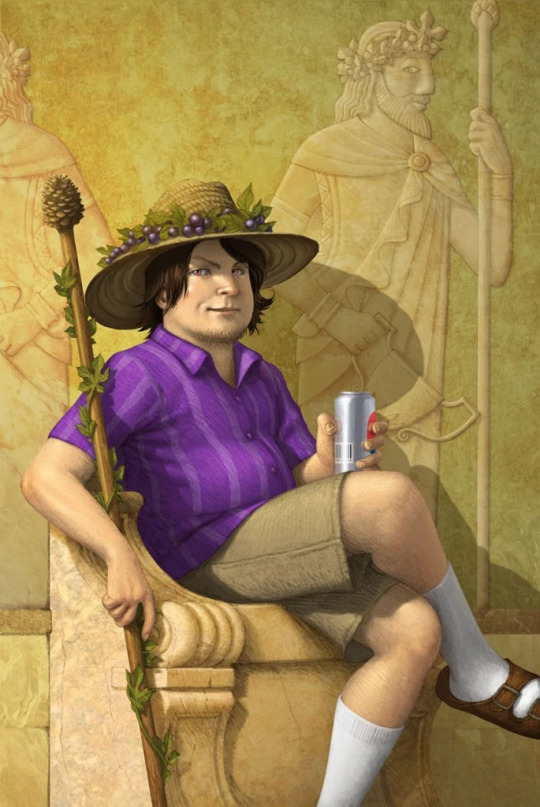
Or how Bacchus’ design evolved in Smite, going from a design originally influenced by the “Silenus-Bacchus” concept (bald, clearly loud and rowdy, with strong, stout, not traditionally pretty facial traits) ; to a new design reflecting more the historical Dionysos as the god becomes youthful, “prettier” in a more conventional way and softer/more delicate in features, while still being fat and bearded:

#dionysos#dionysus#bacchus#greek gods#greek mythology#art#painting#ancient greece#aristophanes#the frogs#silenus#fatness#plus size#big beautiful man#renaissance painting#canon of beauty#cultural evolution
103 notes
·
View notes
Text
Yijun Bai
Author's Note: this is 1 of 3 mcs, I'll link the others when they're posted.
Credits: This is a mc for the interactive fiction game-thingy Infamous. Find it here @infamous-if

Preferred Name: Yijun Bai
Alias: Juniper
Gender + Pronouns: man + he/him ("I know I look feminine, you don't need to tell me")
Singing/Voice Claim, if any: Cowboy Malfoy for his singing voice and his speaking voice lol
Age: 26
More About Him: Yijun Bai and Juniper are like two completely different people. Juniper is Yijun's stage name/act, as such he acts very different. The change is so stark it's often jarring to strangers, acquaintances and even friends.
Juniper is portrayed as a flirty drunken fool. He acts drunk or tipsy even when it's been days since his last drink. He flirts with everyone; fans, interviewers, other bands(👀). He often seems clueless as to what happens around him and acts overly laid back. Contrasting Yijun's usual punk-grunge clothing Juniper wears loose, flowy shirts and pants in various shades of wine red, purple and black. He has a sense of careless laziness that clouds everything he does.
Yijun himself is serious and has a no-nonsense attitude. He seems to despise the stage act he's made, but can't seem to shake it no matter how hard he tries. He has a 'devil make care' attitude and does mostly whatever he wants. He's loyal to a fault, and once you make it into his inner circle it's hard for him to hate you. Yijun is willing to do anything for his friends. He tends to be very calculated and aggressively blunt.
Two things that don't change between 'personas' is his general non-conformity and his love of nature. He strives to stand out in as many ways as possible; the blatant promiscuity and generally flowy-ness of his stage act and his normally aggressively in-your-face view points about the world are the first examples that come to mind. And his love of nature. He does everything he can to lessen his effect on his environment and cares a great deal about the wilderness. He hikes when he has the time and is known to go camping regularly. He's stated that sometime after he retires he wants to live in a cabin in the woods, away from people and engrossed with the forest around him.
Fun Facts:
His Pinterest here.
His(and the others because I'm ✨uncreative✨) band is called The Cult of Dionysus, specifically so he can call his fans Dionysians since he thought that was cool as fuck. Does NOT promote any of the shenanigans that actually went on and is willing to publicly denounce someone if they try something. ("Guys, don't try to replicate anything the actual fucking cult did. For the love of fuck, do not. That's a warning.")
He's fairly superstitious, thanks to his family also being superstitious.
He has a routine he tries to follow closely and if it gets messed up somehow it ruins the rest of his day.
He tends to suppress his emotions and gets frustrated when he does end up feeling them. This also makes him kind of oblivious to some things and a little insensitive, but he's quick to apologize. He's emotionally constipated, please bare with him. ("I'm sorry I said something hurtful to you, I didn't mean to hurt you like that. I don't have a excuse, but I truly am sorry.")
He wants to be covered in tattoos and is getting there slowly but surely. If you ask about them, he'll explain why he got them and what they mean.
Yijun is not close to his family; they're very traditional and conservative people while he's the exact opposite. ("My family? You don't need to know about them")
He likes photography and specifically favors those polaroid cameras. He'd like to have a photo wall, but hasn't settled in a place long enough to build one up.
Yijun doesn't like interacting with his fans, not because he doesn't like them but because he's scared he'd say something wrong and hurt or offend them. Will happily give hugs and pose for pictures if asked.
While Lani wants a PO Box, I feel Yijun would actually have a PO Box and treasure each and every little thing sent to him. You could send him a rock and he'd be 🥺🥺🥰🥰🥰
You know the way parents embarrass their kids by constantly bragging about them? Yijun does that with his fans lol
He's a fucking tsundere lol would absolutely accidentally say some variation of 'it's not like I like you or anything!' lmao
Yijun is one of my regular ocs and has his own story. His 'pre-made' backstory is that he met Lani when he was like 8. In high school he met Storm, and shortly after started a band. In said band he's the lead singer and drummer, among other things.
"I'll stick with you from now on, so you better not fuck this up."
32 notes
·
View notes
Text
ACOTAR plot -> Saint Teresa of Avila -> The mansions of the inner castle -> The ecstasy of St. Teresa -> The erotization of pain in the church -> notions/manifestations of spiritual duality and its effects on the church (1500s) -> dionysian mystical theology
2 notes
·
View notes